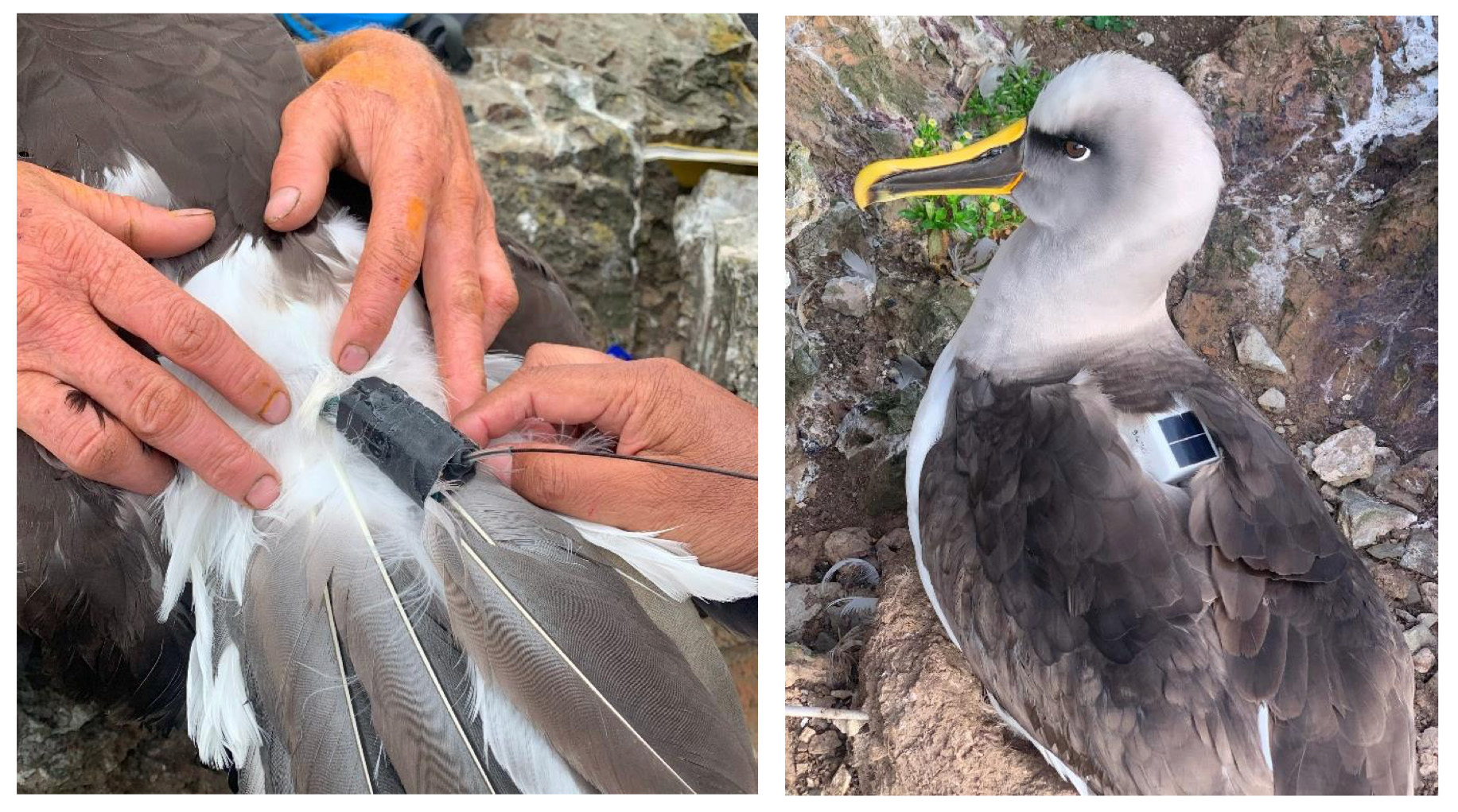 From the report: Fig 1. A tail mounted Telonics PTT device (A) and a body-harness mounted TechnoSmart PTT device (B) fitted to a Northern Buller’s Albatross. The latter was fitted as a test for a couple of hours only.
From the report: Fig 1. A tail mounted Telonics PTT device (A) and a body-harness mounted TechnoSmart PTT device (B) fitted to a Northern Buller’s Albatross. The latter was fitted as a test for a couple of hours only.
A report by Mike Bell and Dave Bell (Toroa Consulting) and Carlos Zavalaga (Universidad Científica del Sur, Lima, Perú) has been released by the Conservation Services Programme of New Zealand’s Department of Conservation. The report is part of an ongoing long-term research project that began in 2021 on populations of Northern Royal and Buller’s albatrosses and Northern Giant Petrels on the Chatham Islands’ Motuhara.
The report’s summary follows:
“Northern Royal Albatross (Diomedea sanfordi), Northern Buller’s Mollymawk (Thalassarche bulleri platei) and Northern Giant Petrel (Macronectes halli) all have significant breeding populations on Motuhara (43⁰96’S, 175⁰83’W). Although research has been undertaken periodically since the 1970’s on these islands, more recently a long-term research project on Motuhara has been initiated since January 2021. Some aspects of this work have been funded by the Department of Conservation’s various programmes, including the Conservation Services Programme and the Budget22 International Seabird Conservation Initiative.
In January 2024, a 10-day field trip to Motuhara was carried out to undertake seabird research. Aims of the trip were varied and included:
- Deploying PTT satellite transmitters on Northern Royal Albatross and Northern Buller’s Mollymawk, including the trialling of a novel leg-loop harness attachment method (DOC AEC 453)
- Deploying and recovering i-got-u GPS loggers on Northern Buller’s Mollymawk
- Retrieving previously deployed GLS loggers on Northern Buller’s Mollymawk, Cape Petrels (Daption capense), and Pyramid Prions (Pachyptila pyramidalis)
- Census breeding Northern Royal Albatross and Northern Buller’s Mollymawk
- Resighting banded Northern Royal Albatross and Northern Buller’s Mollymawk at various study colonies
- Retrieving trail cameras set up to recording breeding activity at Northern Royal Albatross, Northern Buller’s Mollymawk, and Northern Giant Petrel breeding areas
- Banding another cohort of Northern Giant Petrel chicks
This report provides a summary of the trip and the associated raw data. Similarly to previous trip reports, no species analyses of data are included, as all these species are long-lived, and demographic data hasn’t been collected for enough years to warrant analyses. This report aims to provide data of the trip’s findings in a similar format to previous trip reports (e.g., Bell 2023).
Unlike previous trips, however, this trip included an additional international component in the form of a secondee from Perú to New Zealand: Carlos Zavalaga (Director de la Unidad de Investigación de Ecosistemas Marinos, Grupo Aves Marinas, Universidad Científica del Sur, Lima, Perú) joined the trip assist with the field research and further strengthen the connection and collaboration between Perú and New Zealand on the conservation of seabirds that are shared between the two countries, including Northern Buller’s Albatross.”
Publication information
Bell, M. 2024. Motuhara seabird research: field trip report January 2024. Report prepared by Toroa Consulting Limited for the Department of Conservation. 8 pp.
29 April 2024

 Français
Français  English
English  Español
Español